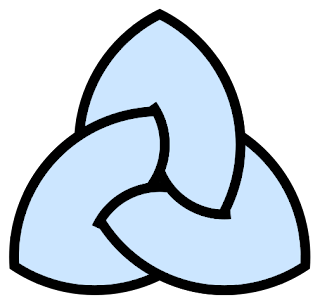 |
| Above the Trinity Knot or triquetra is interwoven with the circle that is symbolic for eternity. |
''The triquetra (/traɪˈkwɛtrə/ treye-KWEH-truh; from the Latin adjective triquetrus "three-cornered") is a triangular figure composed of three interlaced arcs, or (equivalently) three overlapping vesicae piscis lens shapes. It is used as an ornamental design in architecture, and in medieval manuscript illumination (particularly in the Insular tradition). Its depiction as interlaced is common in Insular ornaments from about the 7th century. In this interpretation, the triquetra represents the topologically simplest possible knot.
The triquetra is often found in insular art, most notably metal work and in illuminated manuscripts like the Book of Kells. It is a "minor though recurring theme" in the secondary phase of Anglo-Saxon sceatta production (c. 710–760). It is found in similar artwork on early Christian High Crosses and slabs. An example from early medieval stonework is the Anglo-Saxon frithstool at Hexham Abbey.
The symbol has been interpreted as representing the Holy Trinity, especially since the Celtic revival of the 19th century and was regularly used as a Trinitarian symbol in iconography. Read more...



No comments:
Post a Comment
All comments are moderated and do not immediately appear after publishing. Have a question about the illustration? Just type it in the comment box and I'll get back to you as soon as possible. Have a nice day!